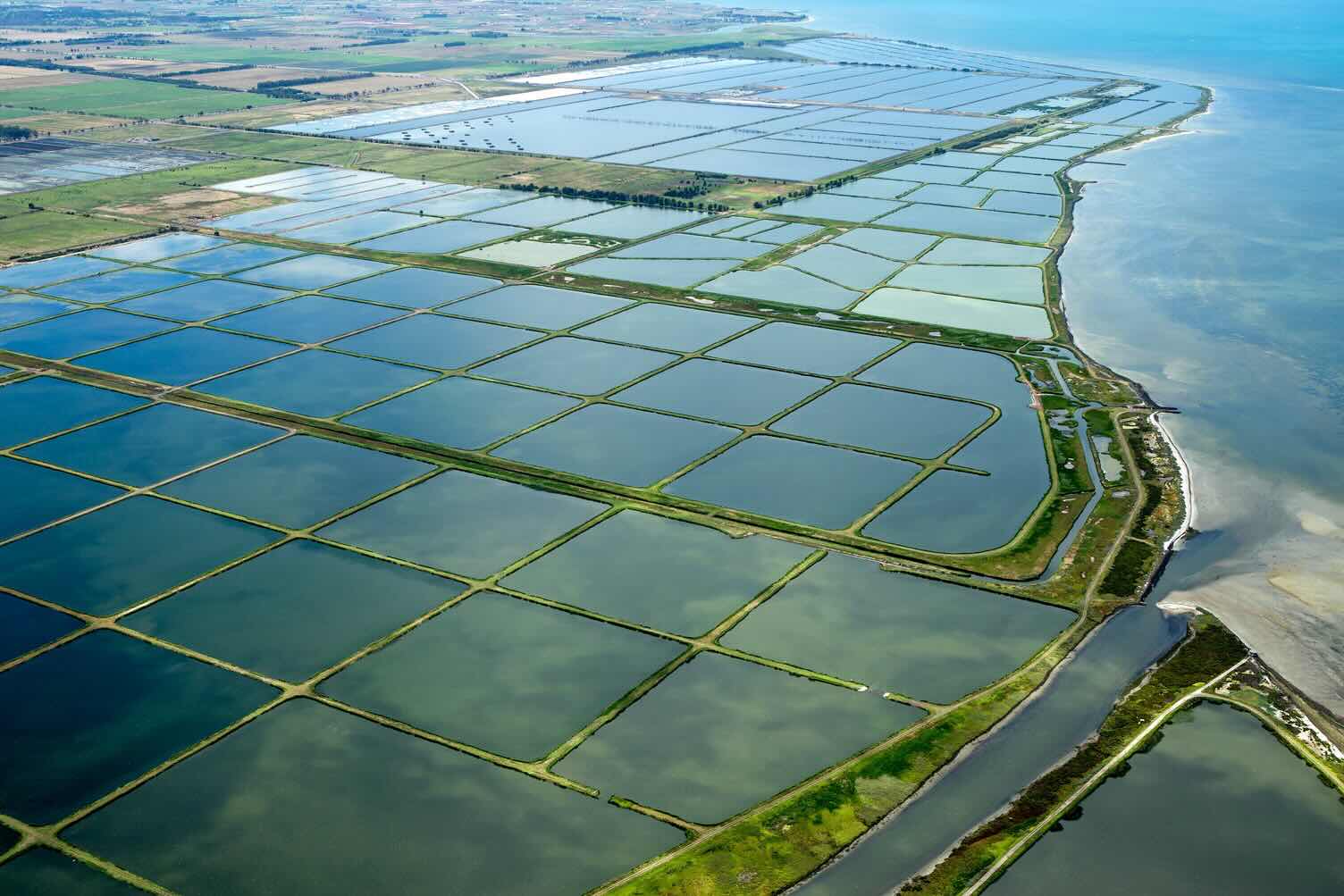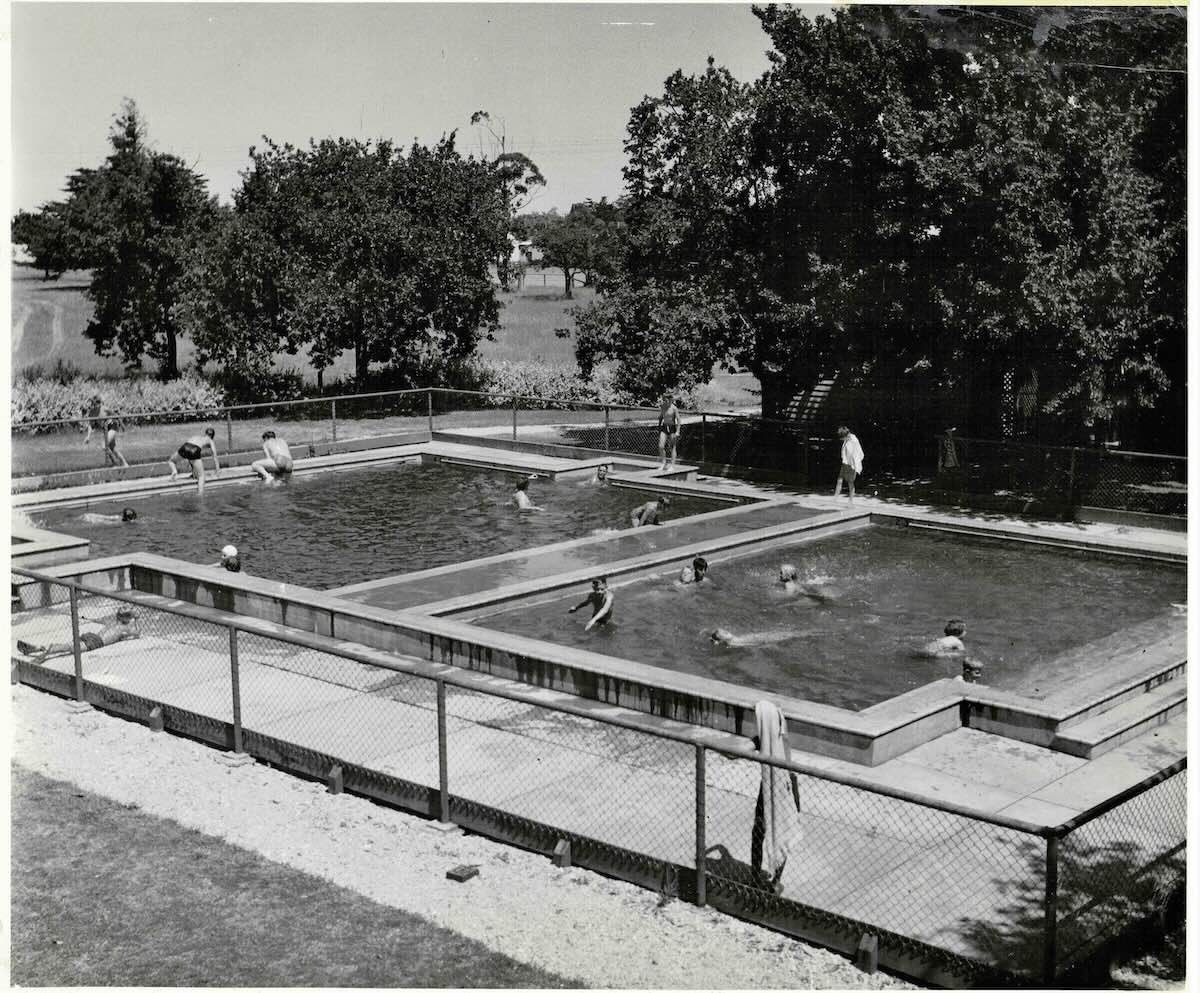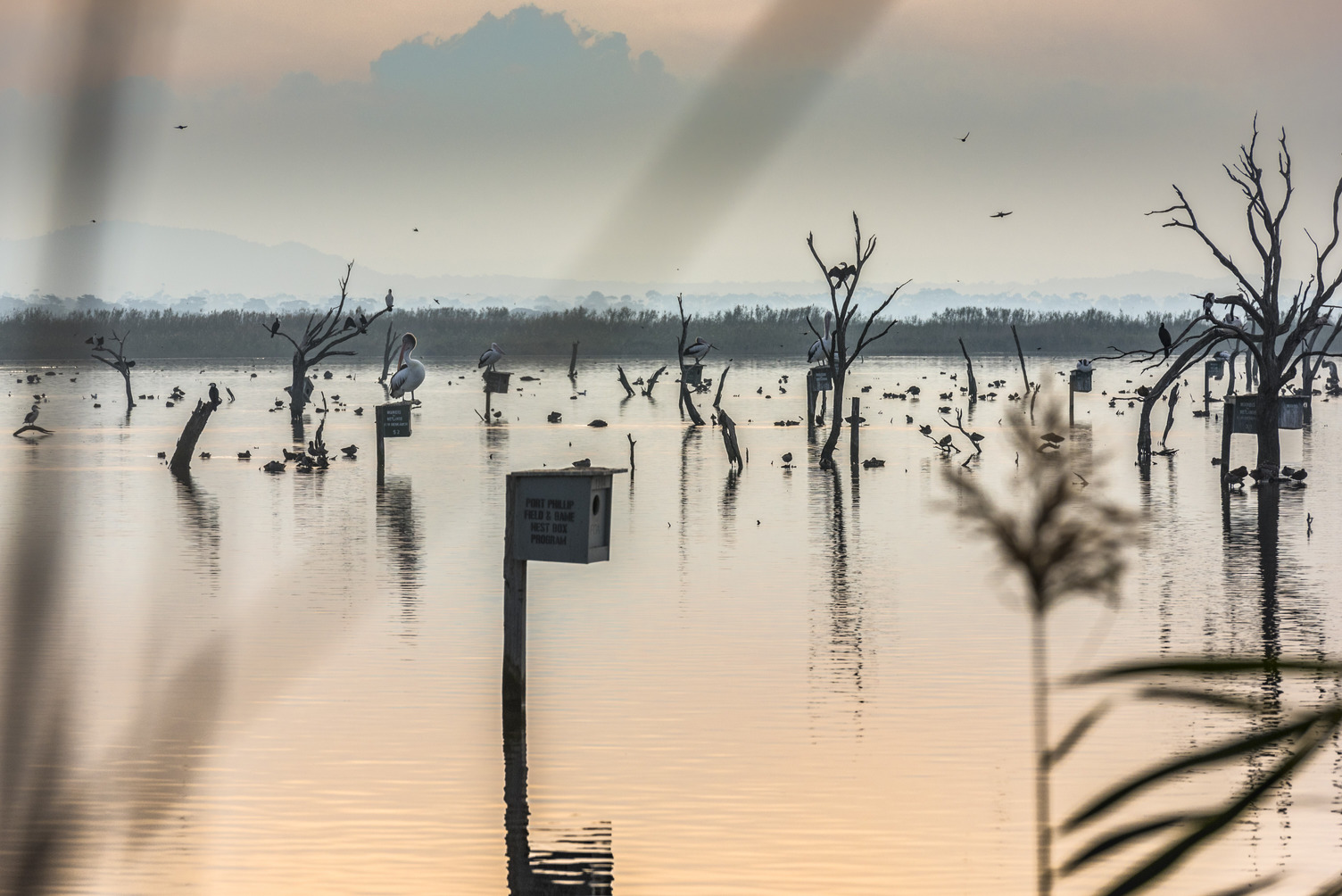“If you want to see what half of Melbourne’s sewerage looks like, look down there,” Kris says.
I move cautiously to the lip of the canal and peer over, expecting some turgid river of nameless sludge. Instead, there’s a briskly moving stream of…yeah, water. Not particularly attractive water. It’s grey and cloudy, the colour of an old cataract, and with occasionally familiar objects (let’s call them ‘objects’) floating in the current. But definitely water.
As I watch, a rogue wet wipe goes sailing past. Black crows caw in the dead-looking pine trees, and the May sky is blue and clear. The air smells surprisingly good considering I’m standing at the mouth, so to speak, of Melbourne’s biggest sewerage in-flow.
“There is no tap here. We can’t turn this off,” Kris says. “We treat all of Melbourne’s west, all of the north, and parts of the northeast. Some of that water down there came from a shower drain in the Yarra Valley.”
Kris Coventry is an engineer and Process Improvement Team Leader at Melbourne’s Western Treatment Plant (WTP), located in the forgotten, tumble-down town of Cocoroc, southwest of the city. Along with thirty other full-time staff, it’s his job to treat two-hundred Olympic swimming pools of sewerage, every day, and keep 10,500 hectares of lagoons, fields, canals and wetlands working as nature and Victorian engineers intended.
The Western Treatment Plant is special, perhaps unique. It’s mostly a natural system. There are no chemicals involved. All it needs is gravity, sunlight and time to turn Melbourne’s sewerages into, more or less, clean water, which is then discharged into Port Phillip Bay. The water that flows in would probably kill you. The water that flows out you can basically swim in.
“It’s astonishing really, considering it was built in 1897,” Kris says. “The Victorians really knew their stuff. This is the biggest waste treatment plant in the world, in terms of area. Nowhere else comes close. We often have international delegates come over, and they just stare at it and just go, ‘Wow…’”
I’m here because, at some point in the not too distant future, it’s likely I’ll be drinking that water down in the canal. And so will you. As Australia gears up for another El Nino period, and with climate change threatening water security around the world, questions like, ‘Where does our water come from?’ and ‘What do we do with it?’ have become kind of important. The human race is always about three days away from dying of thirst, and it’s no longer a gigantic imaginative leap to imagine some Mad Max hellscape where civilisations wage war over bottles of Evian.
We’re not quite there yet, obviously, but with that in mind, governments everywhere are increasingly looking to diversify their water portfolios, from catchments and dams to desalination plants, aquifers and (yep) purified recycled wastewater. AKA sewerage.
“Every year, the next drought is one year closer,” Kris says, staring down at the current. “And if you lose sewerage, then things can quickly go zombie apocalypse.”
“…if you lose sewerage, then things can quickly go zombie apocalypse.”
This stuff is particularly important here in Australia. We’re the driest inhabited continent in the world. Around seventy percent of the country is arid or semi-arid land, which means it gets less than 250mm rainfall per year. In 2020, New South Wales alone had nearly fifty towns counting down to Day Zero, the recognised industry term for ‘Nothing Left To Drink’.
Australia is rich in a lot of things, but H2O isn’t one of them, and our climate is temperamental at the best of times. Which is why we have one of the most sophisticated national water management schemes on the planet.
“When we talk about water security, we have to assess our options,” says Danielle Francis from the Water Service Association of Australia. “The big ones are surface water – that’s rivers and dams. Next you’ve got groundwater and aquifers. And then you have desalination and what we call ‘purified recycled water’.”

NATURE AND ENGINEERING UNITE: The Western Treatment Plant, in Cocoroc, is a remarkable feat of engineering and ecology, processing Melbourne’s sewage while nurturing vast wetlands, safeguarding public health and the environment.
Where your water comes from depends on where you live, but as a general rule, about eighty-two percent of Australia’s water comes from the surface: that’s dams, catchments and rivers. Eight percent comes from groundwater aquifers, which not every city is lucky enough to have. Four percent comes from six major desalination plants, which were all built during the Millennium Drought (1997 to 2009, and said to be the worst drought since European colonisation). And six percent comes from recycled water, which (at the moment) is mostly used for non-residential stuff like commercial cooling and irrigating crops.
“The problem is, with climate change, the reliability of traditional sources of water isn’t as good,” Danielle says. “We need what we call rainfall independent sources of water, which is basically purified recycled water and desal.”
It’s not just drought either. Every time there’s major flooding and storms, or wind-driven ash from bushfires, Australia’s surface water becomes compromised. Impurities in the catchments that would usually settle over time, making water treatment easy, churn around and clog the system. Heavy metals wash in from industrial sites. Cremated gum trees settle on the surface.
“When the Queensland floods started coming through in 2011, the major treatment plant up there was basically dealing with mud. And you can’t treat that to drinking water standards,” Danielle says. “By having a desal plant running one-hundred percent, they could take the pressure off the treatment plant.”
Unfortunately, as anyone who’s looked at a weather map in the last five years knows, ‘once-in-a-generation’ climate events now seem to happen approximately every Tuesday, so staking eighty percent of your country’s drinking water on rivers and dams is no longer a viable strategy. State and federal governments are keenly aware of this, which is why they’re looking at all contingencies. Recycled sewerage among them.
“The phrase we use is ‘All options on the table’,” says Danielle. “We know we can take water from any source and treat it to whatever quality we need to. We’ve known how to do this from a technological standpoint for a long time.”
What Danielle’s getting at is that drinking recycled wastewater isn’t as controversial as you might think. Thirty-five cities around the world already do it, and forty more are looking into it. You can sip recycled water in Cape Town, London, Barcelona and Bangalore. It emerges from taps up and down the Californian coast. In Australia, we already have the Western Corridor Recycled Water Project, built as a drought backup in Queensland in 2008, plus a stormwater-to-drinking-water plant in Orange, NSW.
But in Australia, the big test case for recycled wastewater is Perth.
In the 1960s, Perth got eighty-eight percent of its water from the surface. Today, that number is about ten percent. The city is one of Australia’s true water diversity success stories, and a possible blueprint for the rest of the country.
In the second half of the twentieth century, the Western Australian government started to realise that what they were going through wasn’t a drought, because droughts end. Facing population growth and unrelenting climate change, Perth simply wasn’t going to be able to keep drinking rainwater forever. So they began to diversify, first with desalination in the 2000s, then purified recycled water in 2017. Over the last ten years, the government has increased the volume of recycled water in Western Australia by about seventy percent.
“Perth just knew, decades ago, that this was coming,” Danielle says. “They said we have to stop talking about drought, because this is just the new normal, and we need to prepare for it.”
But even Perth is a late adopter when it comes to purified recycled water. Some of the first modern schemes emerged in California in the 1960s, with places like Montebello Forebay pioneering the use of recycled wastewater to recharge underground aquifers. The next big one was Windhoek in Namibia, in 1968, which became the first city in the world to produce drinking water directly from municipal wastewater. In other words, this isn’t radical science or anything. We’ve understood how to treat almost any water to drinkable a standard for a long, long time. It’s two hydrogen atoms, one oxygen atom. That’s the secret to all life.
“This isn’t a technical problem. It’s a social problem,” Danielle says. “We have to bring the community along for the journey.”
“This isn’t a technical problem. It’s a social problem.”
***
The 4WD rattles as we drive along one of the service roads connecting the various lagoons of the Western Treatment Plant. Kris is taking me to the outflow, where the treated wastewater reaches the end of its journey and flows into Port Phillip Bay. We pass huge ponds covered in acres of white plastic. Under there, biogas is being farmed to generate electricity.
“We’re actually self-sufficient here,” Kris says. “We generate about 130 percent of the electricity we need. It’s a similar process to what happens in your stomach: the microbes break down the waste and release methane. We seem to get the most power at about thirty-seven degrees, which is coincidentally the same temperature as the human body.”
From these covered pools, the water flows gently south, rippling along carefully engineered gradients into the lagoons: giant man-made rectangular pools, the first of which was built in the 1930s. This is where the real magic happens. Water slowly spills diagonally, from lagoon to lagoon, zigzagging back and forth, becoming more pure with each pass.

COCOROC SWIMMING POOLS CIRCA 1900.
“It takes between a month and two months for a shower in Melbourne to make its way to the discharge,” Kris says. “And during that intervening time, it’s just sunlight, nature and microbiological activity doing its thing.”
Soon our way is blocked. There’s another car moving along the one-way track. “Probably a twitcher,” Kris says. “See?” He points beyond the car, and I can see a flock of water birds shimmy up from the long grass.
This is something I hadn’t expected. Melbourne’s biggest sewerage treatment plant is also one of Australia’s most valuable migratory bird habitats. In terms of diversity and abundance of bird life, this man made patchwork of wetlands and lagoons literally rivals Kakadu National Park. Around one third of all bird species in Australia have been spotted here. As such, the plant maintains about four-thousand bird-watching permits. This means that areas of Melbourne’s critical water infrastructure, which I assumed would be off-limits, perhaps patrolled by guards holding machine guns, are instead populated by boffins with binoculars. They also seem to have right of way. The twitcher gives us a disgruntled look as we turn off to let him past.
Finally we make it to the outflow, where the last lagoon, built in the 1980s, empties into the sea. By now the water has gone through a couple of months of purification, and the natural microbes have done their busy little work. You could swim here, if you wanted to. Journalistic thoroughness notwithstanding, I decide to watch from a safe distance.
There’s not much at the outflow. Just tidal wetlands and weedy scrub where roughly eighteen-thousand shorebirds come to feed, and some small markers fifty yards offshore, warning boats not to stray too close. A small, nondescript channel of blue water is the final evidence of Melbourne’s waste. As we look out to sea, a flock of pelicans soars past, high overhead.
“The birds eat the bugs and grubs that live in the intertidal zone,” Kris says. “And those bugs in turn eat the phytoplankton, which in turn feeds off our nutrients.”
The Western Treatment Plant is allowed to discharge three-thousand tonnes of nitrogen into Port Phillip Bay each year. That’s what makes this place bird mecca. In a lot of ways, this processing plant literally feeds the bay. During the Millennium Drought, when Melbourne’s water use hit all-time lows, the lack of nutrients flowing from WTP threw Port Phillip’s whole ecological system out of whack. Seagrass in Portarlington massively declined. Fish stocks were way down.

BIRD HAVEN: Unused lagoons at the Western Treatment Plant now serve as thriving bird sanctuaries.
“It’s this bizarre thing,” Kris says. “This plant has been here so long that a lot of the ecology of the bay relies on it.”
Clouds gather over the wind-blown sea. Out there, invisible water molecules are being evaporated to fall on the land and start the whole cycle again. And this is another thing that doesn’t get talked about much in the whole treated sewerage debate. Apart from fresh water locked away in polar ice caps, literally all water is recycled. All the time. That’s how water works.
This sounds like an obvious thing, something you learn in primary school, but it’s so obvious that it often gets taken for granted. The water that comes out of your tap is the same water that was drunk by dinosaurs. If you live in a city near a river mouth, chances are that the water in your glass has already gone through seven sets of kidneys before it gets to you. And that’s just on this journey. Apart from meteors, UFOs and a sprinkling of hydrogen atoms, Earth is pretty much a closed system: nothing gets in, nothing gets out. And, notwithstanding some seriously expensive, inefficient and highly flammable tech, you can’t make new water. At least not in volumes that will do civilisation any good.
That leaves us with two options: we can find new sources of water, like desalination and recycling, and or we can learn to use water better.
“I asked a colleague the other day, if you had $10 million to spend on water, what would you spend it on,” Kris says, “and he immediately said: education.”
“The top priority is always water conservation,” Danielle agrees, “teaching people how to use water properly. We shouldn’t be spending a single dollar on water infrastructure until we’re making sure we’re squeezing the value from every last drop.”
The research suggests that education does work. As a rule, the more we learn about purified recycled water, or any new water technology, the more open we become to using it. The more we learn about water conservation, the better we get at it. Squeamishness is really just a symptom of ignorance. It’s the big reason why the Western Treatment Plant runs school excursions most days of the week: you need kids to see this stuff in order to value it.
Lucas Van Vuuren, the guy who pioneered Namibia’s Windhoek recycled water scheme back in the 1960s, had a saying: “Water should be judged on its quality, not its history.” What he meant was that it doesn’t matter where water comes from, because all water eventually comes from everywhere. What matters is how good that water is, and what we do with it.
“It’s only wastewater if you waste it.”
“It’s only wastewater if you waste it,” Danielle says. “Just look at Cape town; the famous Day Zero situation. In 2018, you had people queuing to get a jerry can full of water. They hit a point where they knew they couldn’t build their way out of this. There wasn’t time.
“But they were lucky – they got rain.”






































